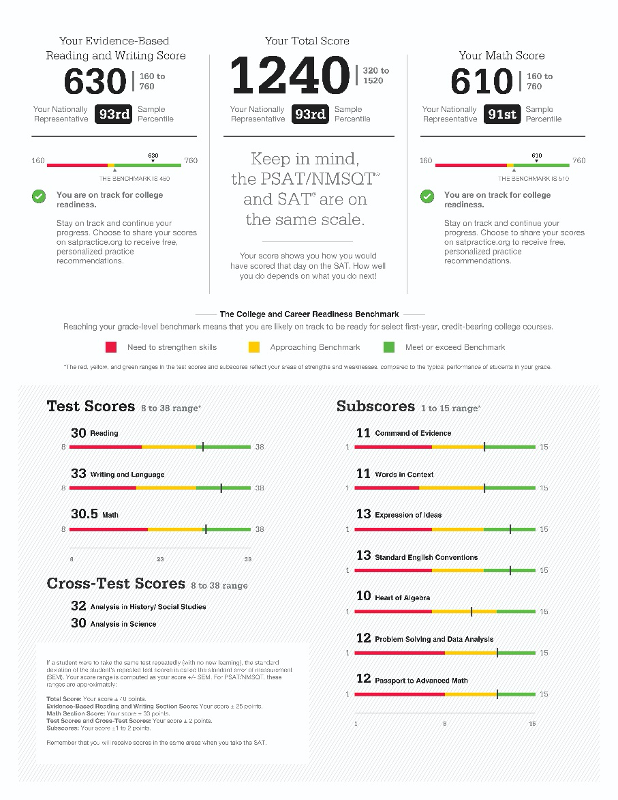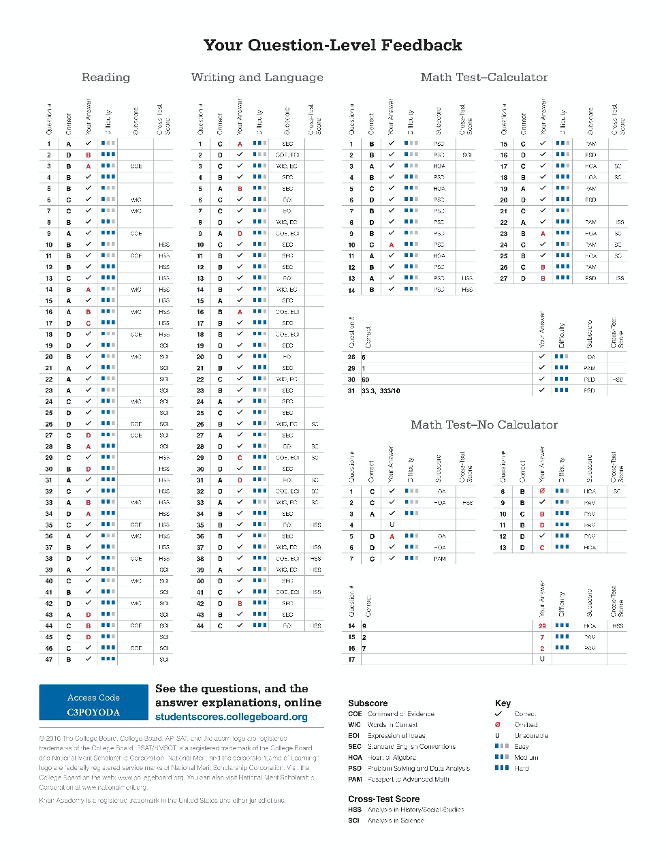The Digital SAT is coming. Get ready to ace it.
The Digital SAT is coming. Get ready to ace it.

No three letters fill high school students with more dread than S-A-T. After years of hard work, students find themselves stuffed into classrooms on a Saturday morning to sit for a three-hour test featuring dense reading passages, tricky math problems, and the constant pressure of a ticking clock. Of course, the College Board insists that the SAT simply tests what students have already learned in school, a claim we gleefully debunk in our article Don’t Get Us Started.
Sadly, though, the SAT is not the only lengthy multiple-choice test students have to contend with during high school. There are also state-required proficiency exams, AP exams, and for most 11th graders (who clearly don’t have enough on their plates), a rite of passage called the PSAT. Also known as the NMSQT, or the National Merit Scholarship Qualifying Test, the PSAT is almost exactly the same as the SAT, except that it’s shorter (except in certain sections), doesn’t count (except when it does), and might be one of the most important tests students take during high school (except when it isn’t).
Confused? So are we. Let’s figure this out together.
So the PSAT Is Exactly Like the SAT?
Well, not exactly. The PSAT features the same four test sections as the SAT—Reading, Writing and Language, Math (No Calculator), and Math (Calculator-Permitted), in that order—but three of the four sections are slightly shorter and feature fewer questions. Here is a chart comparing the SAT with its little sibling, the PSAT.
| SAT | PSAT | |
|---|---|---|
| Total # of Questions | 155 | 139 |
| Total Hours of Your Precious Life Robbed by the No.2 Pencil-Industrial Complex | 3 hours | 2 hours and 45 minutes |
| Reading Test | 52 questions in 65 minutes. | 47 questions in 60 minutes. |
| Writing and Language Test | 44 questions in 35 minutes. | 44 questions in 35 minutes. |
| Math Test (No Calculator) | 20 questions in 25 minutes (no calculator permitted). | 17 questions in 25 minutes (no calculator permitted). |
| Math Test (Calculator-Permitted) | 38 questions in 55 minutes (calculator permitted). | 31 questions in 45 minutes (calculator permitted). |
| Essay Test | Optional 50-minute essay section at the end of the SAT. | Srsly? A 50-minute essay? After three hours of reading, writing, and math questions. Geez… |
| Impact on College Admissions | Used as one factor in the college admissions process. | Used to give students an idea of how they’ll perform on the SAT and to qualify students for the National Merit Scholarshiph Competition. |
As you can see, the PSAT is essentially just an abridged version of the SAT, with slightly shorter sections in math and reading. The most notable difference between the PSAT and SAT pertains to scoring. While the SAT is scored on a 1600-point scale, with students earning up to 800 points each in Math and “Evidence-Based Reading and Writing” (the College Board’s official term for verbal), the PSAT is scored on a 1520-point scale, with test-takers earning up to 760 points each in Math and “Evidence-Based Reading and Writing.”
OK, So the PSAT is Just a Practice Test?
For students who don’t earn some level of distinction in the National Merit Scholarship Competition (more on that momentarily), yes, the PSAT is simply a practice test for the SAT.
However, as practice tests go, it’s a pretty good one.
First, taking the PSAT at school is really different than working through a book of practice tests at home. Understandably, most students find the pressure of taking a test while surrounded by their peers and under the watchful eye of a proctor to anxiety-provoking. The PSAT provides this experience, in effect desensitizing students to the process of taking a lengthy, challenging test at school.
Further, the PSAT offers detailed score reports that help students pinpoint their primary areas for improvement. Every student who takes the PSAT receives a score report that looks like this:

When most students check out their PSAT score report, they only focus on the scores centered in big, boldfaced font all the way at the top (for example, the 1240 in the sample report above). And while those topline scores are of course important, they don’t tell the whole story. The more actionable information is actually on the bottom half of the page, where the sub-scores are reported on a scale from 1 to 15.
The best way to view a PSAT score report is to think of it as a detailed Profit & Loss statement. Just as a business owner who is trying to figure out how to make her company more profitable needs to examine the individual expense categories in a Profit & Loss statement to see where all the money is going, high school students need to look beyond the topline numbers of their score report and focus on the individual categories of incorrect questions to see where the majority of points are being missed.
If you look at the sub-scores section of our sample PSAT report, you’ll see that the student scored the lowest in “Heart of Algebra,” which is the College Board’s fancy term for “Geometry and Algebra I.” Clearly, this student should begin prepping with a thorough review of these topics, some of which she might not have studied for years.
Another useful part of the PSAT score report is the “Question-Level Feedback,” pictured below:

Here, students can see which questions they got right and wrong, along with an indication of each question’s difficulty. Often, students are surprised to find that they missed a fair number of “easy” questions along with the hard ones. What these students don’t realize is that they aren’t missing easy questions because they don’t understand the underlying concepts. They’re missing easy questions because they’re falling for tempting trap answers.
Students should also see whether they missed more questions toward the end of each test section than in the beginning or middle. Students often assume that a performance drop-off stems from the rising difficulty of the questions, but such declines are more likely to result from struggles with time-management, one of the most important skills test-takers need to succeed on the PSAT, not to mention the even-longer SAT.
I Crushed the PSAT. Am I a National Merit Scholar? Where’s My Money?
As we mentioned earlier, beyond serving as a practice SAT, the PSAT also functions as the qualifying test for the National Merit Scholarship Competition. While the vast majority of test-takers won’t qualify, those who do are rewarded with the prestigious distinction of being a National Merit Scholar, not to mention the possibility of college scholarships.
However, the National Merit Scholarship Competition is more complicated that just rewarding the top scorers on the PSAT. First of all, the competition is only open to high school juniors. Ninth and tenth graders aren’t eligible, even if they earn a perfect score.
Next, while the National Merit Scholarship Corporation (the nonprofit that runs the National Merit Scholarship Program) uses the PSAT as its qualifying test, the organization doesn’t use the simple topline PSAT score. Instead, the NMSC uses something called a “Selection Index.”
What Is the Selection Index?
According to the good people at the National Merit Scholarship Corporation, the Selection Index is determined by “doubling the sum of the Reading, Writing and Language, and Math Test scores.”
At first glance, it might sound like the Selection Index is just your total PSAT score times two, but that’s not the case. Instead of multiplying both the math and verbal scores by two to calculate each student’s Selection Index, the National Merit Scholarship folks only double students’ “Evidence-Based Reading and Writing” score. The math score is not doubled. Therefore, the verbal sections of the PSAT are effectively given twice the weight of the test’s math sections, which means that students who are talented in the Humanities have a far greater chance of attaining a National Merit Scholarship than those gifted in STEM.
Finally, just to make sure process of calculating each student’s Selection Index is as convoluted as humanly possible, the National Merit Scholarship Corporation also divides the sum of “double each student’s verbal score plus his or her math score” by ten. The result can be summed up by this totally intuitive, not-in-the-least-bit-confusing formula:
[2(PSAT Reading and Writing Score/10)] + (PSAT Math Score/10) = Selection Index
And from there, it gets even more complicated. Instead of taking the top scorers from across the country, the roughly 16,000 National Merit Semifinalists are determined on a state-by-state basis, meaning that some states have much higher cutoff scores than others. To give you an idea of the significant difference in qualifying scores from one state to the next, here are a handful of states along with the most recent Selection Index students needed to qualify for Semifinalist status:
| Alabama | 212 |
| California | 222 |
| Florida | 216 |
| Maryland | 221 |
| Michigan | 216 |
| New Jersey | 222 |
| North Dakota | 209 |
| Texas | 219 |
As you can see, if you are a student in New Jersey, for example, you will have to score much higher to qualify than you would if you lived in Alabama, Florida, or Michigan. Is this fair? Arguably not, but it’s the way the system works. In order to qualify for Semifinalist status (or higher) in the National Merit Scholarship Competition, your Selection Index needs to put you in the top half of one percent of test-takers in your home state—that’s the top 1 out of every 200 students.
Students who qualify as Semifinalists are then invited to submit an application, and roughly 15,000 of the 16,000 Semifinalists become Finalists. Of this group, about half receive National Merit Scholarships of some kind. Some of these scholarships are one-time payments of $2,500 toward a student’s first year of college, while others involve $2,500 for each of the student’s four years of undergraduate study.
In addition to Finalists and Semifinalists, the Competition recognizes another group of high scorers, known as “Commended” students, whose scores are strong enough to place them in the top 50,000 students nationwide but not quite high enough to meet the Selection Index cutoff for their individual state.
All This for a Test Colleges Don’t Even Look At?
Well, that’s the thing about being a National Merit Scholar. Even though colleges won’t see your PSAT score, they will be impressed if you receive any kind of distinction in the competition, even if you don’t ultimately receive a National Merit Scholarship in the end. Any recognition in the National Merit Scholarship Competition is a genuine achievement, and that accolade won’t be lost on admissions officers trying to decide who gets in among tens of thousands of qualified applicants.
What About the PSAT 10 and the PSAT 8/9?
The PSAT 10 is a version of the PSAT that is given to 10th graders in the spring. Think of it as the PPSAT (Preliminary Preliminary SAT). Just as the PSAT leaves off some advanced topics covered on the SAT, the PSAT 10 leaves off some of the more challenging topics covered on the PSAT.
And the PSAT 8/9? You guessed it. It’s essentially a PPPSAT (Preliminary Preliminary Preliminary SAT) given to eighth graders to “help them determine if they’re on track for high school and beyond,” according to the College Board, which clearly has its finger on the pulse of the average middle schooler.
Neither the PSAT 10 nor the PSAT 8/9 qualifies students for any National Merit Scholarship. Also, as of now there isn’t a PSAT 6/7, a PSAT 4/5, or a PSAT Kindergarten in the works, but it wouldn’t shock us if the College Board was looking into these additional revenue streams—er, educational assessments.
Wait, So Is the PSAT Important or Not?
The answer ultimately comes down to each individual student. For students whose test-taking chops put them in a strong position to attain some level of distinction in the National Merit Scholarship Competition, the PSAT is quite important. But even for the rest of us mortals, the test represents much more than mere practice. Think of the PSAT as a full-contact scrimmage performed under stadium lights. The PSAT serves as students’ first exposure to a challenging standardized test and the detailed data within the score report helps students pinpoint their greatest areas for improvement, a key step in preparing for the SAT.
One Last Thing. Back to the Selection Index. I See That North Dakota Has a Much Lower Cutoff Score Than My State’s. Should I Traipse into the Living Room and Ask My Parents to Move Me and My Sister to Fargo?
Yes.

Contact
Schedule a Free Consultation,
9 a.m. – 9 p.m. EST
info@LearnThePlaybook.com
Career and Teaching Opportunities
Inspire@LearnThePlaybook.com
© 2021 Learn The Playbook LLC. All rights reserved
Class 1: MON, JUL 1, 2024, 7:30 PM – 09:00 PM EDT
Class 2: MON, JUL 8, 2024, 7:30 PM – 09:00 PM EDT
Class 3: MON, JUL 15, 2024, 7:30 PM – 09:00 PM EDT
Class 4: MON, JUL 22, 2024, 7:30 PM – 09:00 PM EDT
Class 5: MON, JUL 29, 2024, 7:30 PM – 09:00 PM EDT
Class 6: MON, AUG 5, 2024, 7:30 PM – 09:00 PM EDT
Class 7: MON, AUG 12, 2024, 7:30 PM – 09:00 PM EDT
Class 8: MON, AUG 19, 2024, 7:30 PM – 09:00 PM EDT
Class 1: THURS, JAN 16, 2025, 07:30 PM – 9:30 PM ET
Class 2: THURS, JAN 23, 2025, 07:30 PM – 9:30 PM ET
Class 3: THURS, JAN 30, 2025, 07:30 PM – 9:30 PM ET
Class 4: THURS, FEB 6, 2025, 07:30 PM – 9:30 PM ET
Class 5: THURS, FEB 13, 2025, 07:30 PM – 9:30 PM ET
Class 6: THURS, FEB 20, 2025, 07:30 PM – 9:30 PM ET
Class 7: THURS, FEB 27, 2025, 07:30 PM – 9:30 PM ET
Class 8: THURS, MAR 6, 2025, 07:30 PM – 9:30 PM ET
Class 1: MON, JUL 1, 2024, 9:00 AM – 10:30 AM EDT
Class 2: MON, JUL 8, 2024, 9:00 AM – 10:30 AM EDT
Class 3: MON, JUL 15, 2024, 9:00 AM – 10:30 AM EDT
Class 4: MON, JUL 22, 2024, 9:00 AM – 10:30 AM EDT
Class 5: MON, JUL 29, 2024, 9:00 AM – 10:30 AM EDT
Class 6: MON, AUG 5, 2024, 9:00 AM – 10:30 AM EDT
Class 7: MON, AUG 12, 2024, 9:00 AM – 10:30 AM EDT
Class 8: MON, AUG 19, 2024, 9:00 AM – 10:30 AM EDT
Class 1: SUN, JUN 23, 2024, 07:30 PM – 09:00 PM EDT
Class 2: SUN, JUN 30, 2024, 07:30 PM – 09:00 PM EDT
Class 3: SUN, JUL 14, 2024, 07:30 PM – 09:00 PM EDT
Class 4: SUN, JUL 21, 2024, 07:30 PM – 09:00 PM EDT
Class 5: SUN, JUL 28, 2024, 07:30 PM – 09:00 PM EDT
Class 6: SUN, AUG 4, 2024, 07:30 PM – 09:00 PM EDT
Class 7: SUN, AUG 11, 2024, 07:30 PM – 09:00 PM EDT
Class 8: SUN, AUG 18, 2024, 07:30 PM – 09:00 PM EDT
100 THINGS MOST TEENAGERS WOULD RATHER DO THAN PREP FOR THE SAT OR ACT